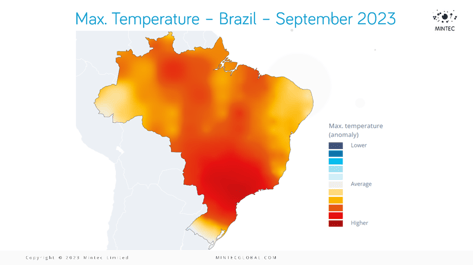 Extreme weather conditions can have a profound impact on agriculture, affecting crop yields and the global supply chain. Recent extreme weather events in Brazil, India, and Australia are having consequences on the production of various crops. From soaring temperatures and droughts to excessive rainfall and flooding, the agricultural sector in these regions faces significant challenges that may ripple through the global market.
Extreme weather conditions can have a profound impact on agriculture, affecting crop yields and the global supply chain. Recent extreme weather events in Brazil, India, and Australia are having consequences on the production of various crops. From soaring temperatures and droughts to excessive rainfall and flooding, the agricultural sector in these regions faces significant challenges that may ripple through the global market.
Brazil: The Heatwave and Its Impact on Oranges
In Brazil, temperatures have soared, with São Paulo experiencing temperatures over 6.5°C above average. São Paulo is a significant hub for Brazilian orange production, making up around 80% of the country's total production. The scorching heat has raised concerns about the quality and yield of oranges. The growing fruit is wilting under the intense heat, and the trees are in the critical stage of flowering and fruit set. This has raised fears that the heat may cause developing fruits to fall, potentially reducing next year's harvest.
Moreover, many orange trees are already weakened by disease, which has been plaguing orchards and causing global orange and orange juice supply issues. While widespread losses have not been reported, growers are on high alert, considering the potential consequences of these extreme weather conditions on the orange industry.
Brazil: Drought and Its Impact on Soybeans and Pepper
Brazil has also experienced below-average rainfall, particularly in regions crucial for soybean and black pepper production. The lack of rainfall is expected to lead to a smaller black pepper harvest this year, reducing yields. Some black pepper plants have even been allegedly killed, which could have long-term effects on pepper production.
Dry conditions in soybean-producing regions have raised concerns about early growth, leading to some cases of sowing delays.
India: Flooding and Crop Damage
In India, excessive rainfall in September, especially in central and northern regions, has caused significant crop damage. Vegetables, pulses, peanuts, and sugar cane have been affected by rain and flooding, encouraging the spread of pests and diseases. Peanuts, in particular, are in poor condition due to excess moisture, which restricted maturation and delayed the harvest.
The sugar cane crop has also suffered damage from floods and pests, exacerbating the issues caused by a dry August. Overall, the excess rain in September may lead to supply issues for various commodities in India, compounding the challenges caused by below-average rainfall during the monsoon season.
Australia: Persistent Drought and the Threat of El Niño
Australia has faced continuous below-average rainfall since July, which is seen as an early sign of the El Niño event. This dry weather has affected the peak growing months for major crops like barley and rapeseed (canola). Production estimates for the 2023/24 crops have been reduced, and there is a growing concern that the dry weather will persist due to the El Niño.
The potential impact of the El Niño on Australian agriculture is a matter of considerable concern. The only hope for mitigating further losses lies in a low-impact El Niño event followed by rain returning to the growing regions. The outlook for Australian agriculture is currently pessimistic, and the next few months will be critical in determining the extent of the damage.
Extreme weather events have the potential to disrupt agricultural production and supply chains in various regions around the world. As seen in Brazil, India, and Australia, the consequences of extreme weather can range from damaged crops and reduced yields to significant supply chain challenges. Monitoring these developments and their global ramifications will be crucial in the coming months, as farmers and industries adapt to the challenges posed by unpredictable weather patterns.

.png?width=145&height=54&name=Mintec_Logo_Small_Use_Mono_RGB%20(2).png)



















